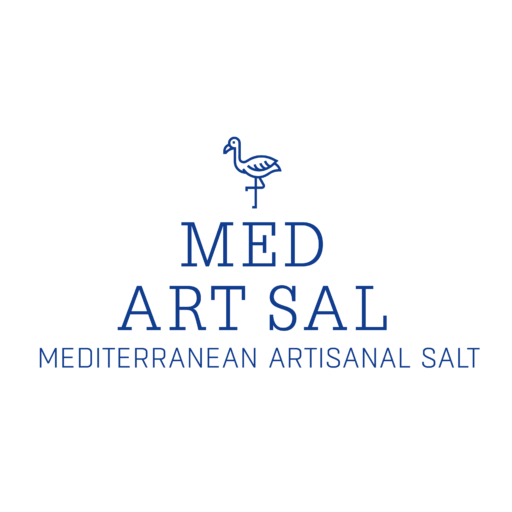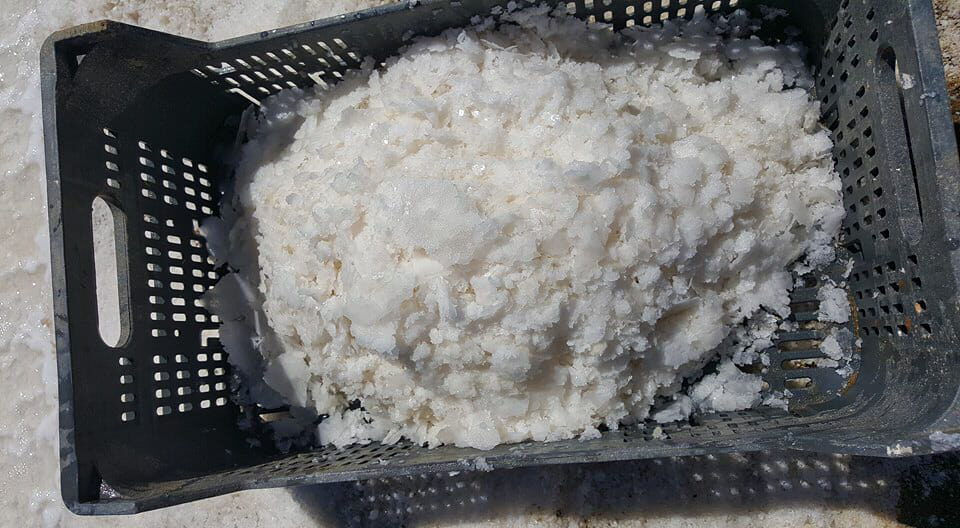TYPES
All the salt that can be obtained on the Earth has marine origin. The use of different terms is due to the need to differentiate its origin or, rather, its crystallization process (which might be thousands of years, in the case of salt mines, or months, in the case of salt flats). Thus, sea salt is understood to be that salt obtained from the evaporation of sea water. Although their composition is similar, each one has different characteristics mainly due to its crystallization and collection.
The natural richness of the sun and the quality of the Mediterranean Sea combine with the expert hands of salt workers to collect a salt rich in minerals and trace elements. In the background, the manual collection and natural washing process in the crystallizer itself with waters with concentrations higher than 25º Beaumé treatment provides a texture, special salty to the salt crystals that give a very special touch that enhances the flavours of any traditional or avant-garde dish, being the most valued by chefs and consumers globally. Furthermore, this process guarantees the presence of natural iodine salts that make subsequent iodination process unnecessary, as well as the presence of calcium, ferric or magnesium salts is guaranteed.
Artisanal salt is not a luxury, but a product that industrialization has reduced to a minority concerned about their health and the importance of ingesting products that are as less processed as possible. In industrial sea salt, there is clearly a loss of minerals, which is why this salt, afterwards, needs to go through an iodization process, turning this product of nature into a chemical one.
Nevertheless, artisanal salt already incorporates all the minerals necessary for human metabolic balance. By following a natural extractive process, artisanal salt contains iodized salts that make it ideal for food use and recommended to avoid problems of hypertrophy of the thyroid gland.
The World Health Organization recommends restricting sodium intake to less than 5 grams of salt per day per person and never exceeding 6. However, most of the world’s population, especially in developed countries, far exceeds the amount, and the average consumption is almost 9 grams. If there is a better salt than another, it will be the one that we put the least possible amount. In this respect, sea salt has a stronger flavour than springs ones. By adding more salty flavour with less amount, it is possible to reduce its intake.
In the waters of the Mediterranean, different types of salts can be obtained with an exceptional quality. The use of one or the other will depend on the tastes of the consumer and the dish to which it is going to be added.
All the varieties of salts mentioned below are identical in composition. If they are analysed, it will be found that their main element is still sodium chloride. It may vary in minute amounts of other elements such as iodine, fluorine, calcium, magnesium or potassium, depending on the part of the sea used to extract the water, in which soil it was deposited or even how hot it was when the water evaporated, but in such minute quantities that they are priceless.
VIRGIN SEA SALT
When the salt is obtained exclusively by the action of the wind and the sun, it is collected by hand and washed only in the crystallizer, without the addition of any ingredient, it may be called “virgin sea salt”. This salt, formed at the bottom of the rafts, is collected with the help of a rake to later load it into baskets and transfer it to the drying point.
The salt formation process depends mainly on the weather, where the ambient temperature, the force of the wind and the humidity are the variables that cause the evaporation of the water within the operating system of the salinas that allows the precipitation and settling of the salt at the bottom of the rafts. These special weather conditions are concentrated in the summer season and with more intensity in the months of June, July and August, although it depends on the latitude in which the salina is located.
Grayish in color, its traditional extraction process gives it specific characteristics:
- It contains approximately only 30% of the sodium normally found in other types of salt.
- As this salt does not suffer any chemical or refining process, the approximately 80 minerals and trace elements such as iron, calcium and potassium that seawater contains remain intact.
- Some of the minerals it contains, such as magnesium, help regulate the proper functioning of some systems such as the nervous one.
- It is saltier than refined salt, so the amounts used in each dish are less.
FLAVOURED SEA SALT
Virgin sea salt may be mixed with some typical Mediterranean seasonings, such as citrus or herbs, with local ingredients or with exotic flavours to create a totally new product whose taste is more impressive than any other seasoning. It is a completely natural process, from the selection of the ingredients to their union. Thus, a new variety of salt is created, which keeps the properties of the sea and adds the properties of the land.
ITALIAN SEA SALT
Italian sea salt is produced from the low waters of the Mediterranean Sea along the coast of Sicily. This salt is naturally rich in minerals such as iodine, fluorine, magnesium and potassium, with a much lower percentage of sodium chloride than regular table salt. This variety adds more “salt” flavor to food, with less sodium, having a delicate taste and plenty of flavor without being too strong.
Commonly referred to as Sicilian sea salts, Sale Marino or Trapani sea salts in reference to the regions producing the salt, the Italian sea salts are milled into fine or coarse grained salts with a cubed crystal shape. They are ideal for salting food before or after cooking: their small grains melt rapidly, allowing them to quickly penetrate the surfaces of food. This variety of sea salt can be used as an ingredient in sauces and condiments or served as a finishing salt for salad greens, meats, poultry, pasta, and fish.
FLEUR DE SEL
Fleur de Sel (Flower of Salt) is obtained through solar evaporation and it is collected manually, therefore, it is considered a type of virgin salt. The difference is that its crystallization occurs at sunset, by thermal contrast, due to the cooling of the brine that reduces its solubility and favors the massive precipitation of small crystals of salt rich in magnesium and fluorine that, due to the lower density of the brine, remain on the surface forming a fine membrane of tiny flower-shaped salt crystals.
Its manual collection, which takes places daily during summer season, is a delicate process, since any disturbance during the crystallization such as extremely strong breezes or rain might undoes the salt crystals and reduces the salinity of the water, making necessary to wait for several days to get the optimum graduation again. The crystals are washed by hand and stored in bags allowing the sun to continue drying them to obtain the Fleur de Sel. This process, as it is natural, allows the properties to remain intact. Fleur de Sel, to be considered as such must not exceed 92,9% sodium chloride, unlike virgin salt, which contains 98%.
This product stands out mainly in haute cuisine for its qualities in flavour and texture. An advantage of Fleur de Sel is that, when placed on food, it does not dissolve quickly unlike other salts, and it remains in its original taste until it is consumed, providing a powerful flavour that highlights and brings out the flavours of other ingredients. Due to its slightly crunchy texture, it is a good accompaniment to meat or fish.
FLAKE SALT
Flake salt is one of the most recognized and used gourmet salt, especially in avant-garde catering and confectionery for its uniqueness and decorative capacity. The flakes are the result of a controlled crystallization of sea water in which the usual parameters involved in the formation of sea salt are controlled: humidity, temperature and pressure, among others.
Its crystallization process is very similar to Fleur de Sel, although in flake salt the action of the wind is more necessary. The result of this production process is a salt whose peculiarity consists in its pyramidal shape (each flake is a small pyramid of salt) and its delicate and crunchy texture. It is a salt designed to finish dishes, to be used at the time of plating, just before serving. They combine very well with grilled and roasted meats, but in general it can be used to decorate and finish dishes of any kind: an example is its growing use in the world of confectionery.
SMOKED SALT
Smoked sea salt, as the name suggests, is a type of salt that is treated with untreated wood smoke to create a stronger flavor and smoky smell in the grains of the salt. Due to its characteristics, it is considered an aromatic salt and also a cooking spice.
At first glance, smoked salt differs from other salts due to its color of a shade between brown, gray and black. This color is not uniform, since not all grains of salt absorb the smoke or oil with which it is prepared in the same capacity. With regard to its granules, they are not uniform in all smoked salt, there are presentations where it looks like a powder, as it is very granulated, and on other occasions the grains are larger.
Smoked salt has great versatility, as it can be used for many purposes, from grilled cuts of meat, seafood, vegetables, to finish a chocolate dessert and even to frost glasses of cocktails.


